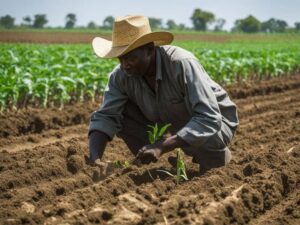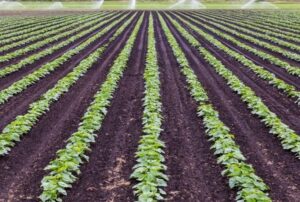5 Best Practices for Variable Rate Technology

Fertilizer application is a crucial aspect of modern farming, directly impacting crop growth, yield, and soil health. In recent years, the agricultural industry has seen the emergence of various innovative technologies, one of the most impactful being Variable Rate Technology (VRT). Variable rate application enables farmers to apply fertilizers at different rates depending on the needs of each specific area of the field. This method not only optimizes the use of fertilizers but also promotes sustainable farming practices by reducing excess nutrient application.
In this comprehensive guide, we will explore the top five best practices for implementing Variable Rate Technology in fertilizer application. These practices will help farmers maximize crop yield, minimize waste, and optimize input costs, all while improving soil health and sustainability.
Understanding Variable Rate Technology in Fertilizer Application
Before diving into the best practices, it’s important to understand how Variable Rate Technology works in fertilizer application. This technology allows farmers to vary the amount of fertilizer applied across a field, tailoring it to the specific nutrient requirements of different areas within the same field. This customization is based on data collected through soil tests, satellite imagery, GPS mapping, and yield monitoring systems.
By leveraging data-driven insights, farmers can apply fertilizer at the optimal rate, ensuring that each crop receives the necessary nutrients for healthy growth. This not only improves crop productivity but also helps in maintaining soil fertility and reducing environmental impact.
1. Leverage Soil Testing for Accurate Fertilizer Rate Determination
One of the most important best practices for variable rate technology in fertilizer application is leveraging accurate and up-to-date soil testing. Soil testing helps determine the nutrient content of the soil and provides valuable information on pH levels, organic matter, and micronutrients. By understanding the specific needs of the soil in different areas of a field, farmers can adjust the fertilizer rate accordingly.
Why Soil Testing is Essential
Soil testing provides a comprehensive analysis of the nutrient availability in the soil. Different areas of a field may have varying nutrient levels, which can affect crop growth. By applying the right fertilizer rate in each area based on soil test results, farmers can prevent over-application or under-application of fertilizers. This practice not only ensures that crops receive the nutrients they need but also prevents environmental pollution caused by excess fertilizer runoff.
Practical Tips for Soil Testing
- Regular Testing: Soil tests should be performed at least once every 2-3 years, depending on the crop rotation schedule.
- Collect Samples Strategically: Ensure that soil samples are collected from multiple locations across the field to get an accurate representation of nutrient levels.
- Interpret Results Correctly: Work with soil testing labs to understand the results and make informed decisions on fertilizer application rates.
By using soil tests to guide fertilizer rates, farmers can make informed decisions on how much fertilizer to apply to each area, maximizing the benefits of Variable Rate Technology (VRT).
2. Integrate GPS Mapping for Precise Fertilizer Application
Another key best practice for variable rate fertilizer application is the integration of GPS mapping technology. GPS systems help farmers map the field accurately, allowing them to apply fertilizers precisely where they are needed. GPS mapping takes into account field topography, soil characteristics, and previous crop yields to create detailed maps that guide the fertilizer application process.
How GPS Mapping Improves Fertilizer Application
GPS technology ensures that fertilizers are applied consistently and evenly across the field. This precise application reduces the risk of over-fertilization in some areas and under-fertilization in others. With GPS-guided equipment, farmers can apply fertilizers more efficiently, saving both time and money while improving crop yields.
Practical Tips for GPS Mapping
- Use High-Precision GPS Systems: Invest in high-quality GPS systems to ensure that fertilizer application is accurate and consistent.
- Combine with Yield Data: GPS maps can be combined with yield data from previous seasons to predict fertilizer needs more accurately.
- Monitor Field Variability: Pay attention to the variability within the field, such as soil types and elevation changes, to adjust fertilizer rates accordingly.
By integrating GPS mapping with Variable Rate Technology, farmers can make data-driven decisions about fertilizer application, leading to better resource management and improved sustainability.
3. Use Advanced Fertilizer Technology for Efficient Nutrient Delivery
Modern fertilizer technology plays a crucial role in improving the efficiency of fertilizer application. Advances in fertilizer formulations, such as controlled-release fertilizers and slow-release coatings, allow for a more targeted and efficient delivery of nutrients. These technologies are especially beneficial when used in combination with Variable Rate Technology, as they ensure that nutrients are released over time in accordance with crop needs.
Benefits of Advanced Fertilizer Technology
- Reduced Nutrient Loss: Controlled-release fertilizers reduce nutrient loss to the environment, ensuring that nutrients are available to crops when they need them most.
- Enhanced Crop Growth: These fertilizers provide a steady supply of nutrients, supporting sustained crop growth throughout the growing season.
- Environmental Sustainability: By reducing nutrient runoff, advanced fertilizers help mitigate the environmental impact of fertilizer application.
Practical Tips for Advanced Fertilizer Use
- Choose the Right Fertilizer for Your Crop: Select slow-release fertilizers or controlled-release fertilizers based on the specific needs of the crops you are growing.
- Match Fertilizer to Growth Stages: Apply fertilizers at different rates according to the growth stage of the crops. Early stages may require a higher concentration of nutrients, while later stages may require less.
- Track Fertilizer Effectiveness: Regularly monitor the effectiveness of fertilizers and adjust application practices based on performance data.
By combining Variable Rate Technology with advanced fertilizer technology, farmers can achieve precise and efficient fertilizer delivery, ultimately boosting crop productivity while minimizing environmental impact.
4. Monitor Weather Conditions to Optimize Fertilizer Rate Application
Weather plays a significant role in the effectiveness of fertilizer application. Factors such as rainfall, temperature, and humidity can influence how fertilizers interact with the soil and plants. For this reason, monitoring weather conditions is an essential best practice when using Variable Rate Technology for fertilizer application.
How Weather Impacts Fertilizer Efficiency
- Rainfall: Heavy rainfall shortly after fertilizer application can cause runoff, leading to nutrient loss and pollution of nearby water sources. On the other hand, dry conditions may reduce nutrient availability to crops.
- Temperature: High temperatures can accelerate nutrient release from fertilizers, potentially leading to nutrient leaching and reduced efficiency.
- Humidity: Humid conditions can affect the evaporation rate of fertilizers, which may influence the timing and rate of application.
Practical Tips for Weather-Optimized Fertilizer Application
- Track Weather Patterns: Use weather forecasting tools and apps to monitor conditions and plan fertilizer application accordingly.
- Apply Fertilizers Before Rain: If possible, apply fertilizers a few days before anticipated rainfall to reduce the risk of nutrient runoff.
- Adjust Application Based on Temperature: Apply fertilizers when temperatures are moderate to avoid rapid nutrient loss due to high heat.
By aligning fertilizer application with favorable weather conditions, farmers can maximize fertilizer effectiveness and minimize waste.
5. Implement Data-Driven Decision Making for Continuous Improvement
The use of data in agriculture is more critical than ever, especially when it comes to fertilizer application. Data-driven decision-making involves analyzing information from multiple sources, such as soil tests, GPS mapping, yield monitoring systems, and weather data, to continuously improve fertilizer application practices.
The Importance of Data-Driven Decisions
By using data to guide fertilizer application, farmers can make informed decisions about how much fertilizer to apply, where to apply it, and when to apply it. This leads to more efficient use of resources, higher crop yields, and reduced environmental impact. Additionally, data-driven decisions allow farmers to track the effectiveness of their practices over time, making it easier to identify areas for improvement.
Practical Tips for Data-Driven Fertilizer Application
- Collect and Analyze Data Regularly: Continuously collect data from soil tests, GPS systems, and weather forecasts to inform fertilizer application decisions.
- Use Farm Management Software: Utilize farm management software to track and analyze all relevant data in one place, making it easier to make informed decisions.
- Adapt to Changing Conditions: Be flexible and willing to adjust fertilizer application strategies based on changing conditions and data insights.
Data-driven decision-making is key to optimizing fertilizer application with Variable Rate Technology. By constantly reviewing and adjusting practices, farmers can improve efficiency, sustainability, and profitability.
Conclusion
In conclusion, Variable Rate Technology is a game-changer in fertilizer application, allowing farmers to apply fertilizers more efficiently, improve crop yields, and reduce environmental impact. By leveraging soil testing, GPS mapping, advanced fertilizer technology, weather monitoring, and data-driven decision-making, farmers can implement best practices that enhance the effectiveness of fertilizer use. These practices not only improve productivity but also contribute to sustainable farming, ensuring that future generations will continue to benefit from healthy soil and abundant crops.
By adopting these best practices, farmers can optimize their fertilizer application process and maximize the benefits of Variable Rate Technology, leading to higher efficiency, reduced costs, and improved environmental sustainability.
To explore more on how to optimize farming practices, check out this guide on wheat cultivation and advanced technology trends in modern farming.














Post Comment